|
The man who never left:
One man’s bond with Jaffna’s Naga Vihara
By Isuri Yasasmin Kaviratne
|
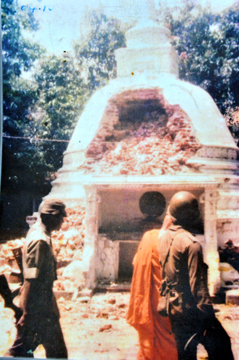
The Naga Vihara in ruins after decades of LTTE
ruling. |
During the years of LTTE control his fluency in Tamil and status as a
long-standing resident kept him safe. He often called himself Chandran
to avoid revealing his ethnicity. Once the LTTE cardres asked him
directly if he was Sinhalese or Tamil. “I told them I was Sinhalese but
had been adopted by a Tamil and had been living in Jaffna since I was 7.
They told me to live well and left,”he recalls with visible traces of
fear and relief.
He sells lotus flowers by the Naga Vihara in the Jaffna town. He is also the
only person who remained at the temple, the only Buddhist temple in the city,
throughout the civil war. He maintained it to the best of his abilities, during
both war and peace. His name is Chandrasena.
He has a long story to tell, about his journey to Jaffna and what his life has
been since. Chandrasena was born in Ruwanwella in 1955 to a Sinhala family but
at the age of 6 he was adopted by a Tamil police sergeant by the name of
Thambiah. Sergeant, Thambiah was transferred to Jaffna and his family, including
Chandrasena, followed him to the town.
The first stroke of ‘misfortune’ struck when the Sergeant passed away due to a
sudden illness. “His family sold all the property they had and left the country.
So I came to Naga Vihara, when I was 8 years old,” he said.
Young orphan
Meegahajandura Wimalaratnethera, the chief incumbent of the temple took this
young boy under his wing. “I was told to work in the temple for a glass of milk,
a bun and 25 cents a day,” thinking it was a good deal, Chandrasena says he
agreed immediately.
|
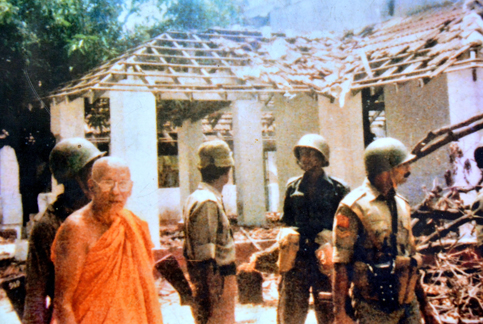
The Naga Vihara in ruins after decades of LTTE rule. |
Those days 25 cents enabled him to feed himself quite comfortably. The temple
monks taught him to read, write and keep accounts. Not content to live on the
charity of the temple in his teenage years the young orphan began working as an
apprentice to a construction worker who paid Chandrasena one rupee for a day’s
work.
For him it was a princely sum and after covering his basic expenses he was able
to donate a part of his earnings to Wimalaratne Thera who would save the money
for him. When he turned 18, Chandrasena was sufficiently skilled to work as a
mason. In his own right – he was on the verge of starting an independent life.
It was precisely at that time that the armed conflict first occurred in Jaffna.
He recalls how the whole Naga Vihara premise was destroyed; all the buildings
were flattened and the only signs that remained of the Vihara were the Bodhi
tree and a mango tree beside it. During the years of LTTE control the temple was
little more than a wasteland. “They cut down the branches of the Bodhi tree and
used the area as a garage,” said Chandrasena.
Safety
|
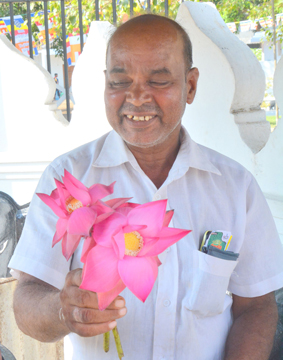
Chandrasena now sells flowers outside the temple |
Wimalaratne Thera was asked to leave Jaffna city during this period for his own
safety. The monk left and would remain away from the temple for 10 years.
Chandrasena however remained though he was not always resident on the temple
grounds he says he visited the area daily even during the fiercest fighting.
During the years of LTTE control his fluency in Tamil and status as a
long-standing resident kept him safe. He often called himself Chandran to avoid
revealing his ethnicity.
Once the LTTE cardres asked him directly if he was Sinhalese or Tamil. “I told
them I was Sinhalese but had been adopted by a Tamil and had been living in
Jaffna since I was 7. They told me to live well and left,”he recalls with
visible traces of fear and relief.
Once Jaffna returned to government control Chandrasena’s life became easier. He
reverted to his original name and soon became involved in the reconstruction of
the Naga Vihara. His benefactor Wimalarathne Thera also returned to the city and
the two would work together to restore their former home.
Contractor
The contract for the reconstruction of the stupa was given to a contractor from
Boralesgamuwa in Colombo. The contractor however was unwilling to commute
regularly to Jaffna to oversee the reconstruction. So Chandrasena soon became
the project coordinator. It was a lengthy project with the work starting in 1997
and completed only in 2002.
|
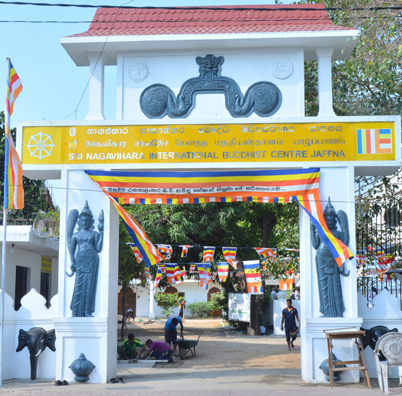
Present day Naga Vihara |
|
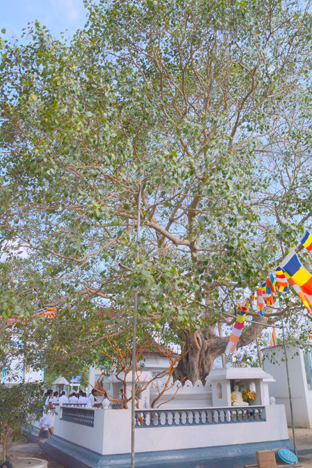
The Bodhi tree that was once cut down by the LTTE |
The significance of the reconstructed temple was such that the then president
Chandrika Bandaranaike Kumaratunga was invited to place the ‘Kotha’ or spire at
the very top of the stupa. However, as the President was unable to reach Jaffna
on account of security concerns Wimalaratne thera decided to proceed with the
function regardless and got the man who never left the temple to place the ‘kotha’.
Kothkerella
The tale of the man from Ruwanwella who ended up placing the kothkerella on Naga
Vihara stupa in Jaffna hit the newspapers.
Among the people who read these articles were Chandrasena’s original siblings
from Ruwanwella and They paid him a surprise visit at the temple, to reconnect
after 51 years of separation.
“I’m very happy that I got to meet my family - even now - the memory of it
brings tears to my eyes… We met… our children met… they had thought I was dead,”
he says, visibly emotional.
Construction is still on-going at the Naga Vihara. A seven story building is
being constructed as a ‘Sangha Vasa’, a residence for monks. Having been
diagnosed with diabetes recently Chandrasena has stopped being actively
involvement in the construction and instead overlooks the construction process
from afar whilst selling flowers just outside the temple gates.
Pix by Saman Sri Wedage
|

